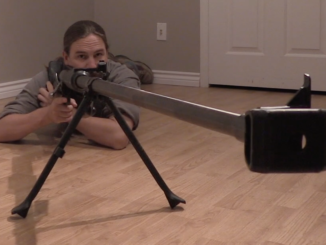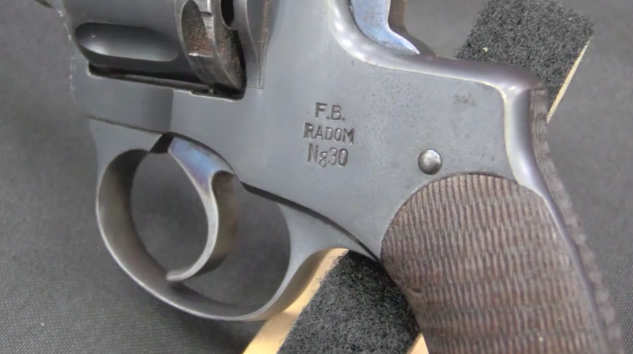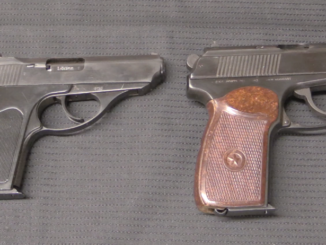The Soviet Union produced more sniper rifles during WWII than any other country, and was one of very few to have a well-developed sniper program in place before the war began. Starting in the early 1930s, they developed a sniper variant of the standard M91/30 infantry rifle, with technical assistance from Germany (of all places). The early (PE) scopes had adjustable focus and 4x magnification, with a relatively large objective lens. Experience in the Spanish Civil War exposed a weakness in the adjustable focus ring of these scopes, and they were replaced by a new PEM version without that feature. By 1940, the plan was to replace the 91/30 with the new SVT-40 as the standard sniper’s rifle. This plan fell apart when the SVT rifles proved to be inferior in accuracy to the Mosins, and not capable of meeting the requirements for snipers.
In a scramble for a new solution, it as decided to just mount the PU scope onto 91/30 rifles. The PU had been designed for the SVT, as the older PEM scopes were too large to effectively mount on the Tokarev rifle. The PU was smaller, lighter, simpler, and cheaper to manufacture, and it made good sense to make use of the development work put into them. They has a smaller field of view and slightly reduced 3.5x magnification – a very pragmatic choice for a country that needed to mass produce weapons in wartime conditions. Starting in 1942, the 91/30 PU sniper rifles began flooding out of Russian factories – by the time major production ended in 1945 hundreds of thousands had been made.
The 91/30 PU was given better fit and finish than the typical 91/30 rifles produced during the war, but they are still rather cruder than the typical Western idea of the custom-made and hand-polished masterpiece sniper’s weapon. These were practical tools, and their design reflects that. Cheek welds in particular are difficult to maintain, because the comb is designed for the iron sights and no riser was provided to make up for the height of the scope. I don’t find the stock particularly ergonomic, and the triggers are not particular outstanding. On the other hand, they can survive plenty of rough handling.
Finding an original Russia PU sniper is difficult today – there are plenty of them out there, but they are hugely outnumbered by fakes. Because of the simplicity of the PU sniper and the price differential between stock rifles and snipers, a whole niche industry has developed in making them. There are new production mounts and scopes being made, and mounted to all sorts of 91/30 rifles. You may find all types of combinations of infantry rifles and ex-snipers (many PU snipers were torn down and returned to infantry configuration by the Red Army after the war), original and reproduction mounts, and original and reproduction scopes. It really take a lot of experience to distinguish the true originals, and I don’t have enough experience to write a thorough article on that (yet). However, determining the validity of the rifle itself is a bit simpler than the scopes and mounts, so here are a couple starting guidelines:
- Any PU dated 1941 or earlier is fake. Also, any 91/30 PU with a hex receiver.
- Any Century import with a new serial number beginning with 9130S is a reproduction. They are real Russian 91/30s, but not originally snipers.
- A sniper made by Tula (star with an arrow in it) will have a cyrillic “СП” marking above the arsenal mark, indicating a sniper. Real ones without this mark do exist, but are very rare.
- A sniper made by Ishevsk will have the scope serial number marked on the left side of the receiver. If there is such a number crossed out without a new one added, it means the rifle started out as a sniper, but was decommissioned by the military (ie, an “ex-sniper”). If it has a scope on it now, it was assembled a commercial seller at some point.
That being said, a reproduction 91/30PU can be a great way to get into the sniper rifle field, as long as you understand what you are getting. They are far less expensive than any type of authentic WWII sniper’s rifle, but will still give you close to the same performance as the originals, if you get a good one.




So I have a “fake” – a 1940 Tula with a post-war scope. I knew it when I bought it….and the price reflected it…about $430 or so. Supposedly RGuns has the only “genuine” snipers and they’re going for $800-$900+. I’ve shown it to a buddy who has a machine shop and he’s impressed with the quality of the mounting. Shoots pretty good – even with the Russian surplus ammo. Some shoot .308 ammo through it which is fine out to 100 yds. But anything beyond that and you get flyers all over the place. I slugged the barrel and pulled a few surplus bullets and for accuracy you really want .311 bullets. Its a fun rifle. Kicks like a mule, has a heavy trigger, unusual sight adjustments but even with a 150 grain bullet it can find the X-ring at 600 yds. I plan to shoot it at Perry in a few weeks. Haven’t found a good reload recipe yet so I may simply shoot the surplus stuff.
Happily the 7.62x54R is produced for military to our times (to use in PK and PKM machine guns) so the source of cheap surplus will not end. 7.62x54R is probably the last rimmed rifle ammunition used by major power.
During the World War 2 some of ShKAS (headstamped Ш i.e. Sh) ammunition due to more strict quality control.
Is “During the World War 2 some of ShKAS (headstamped Ш i.e. Sh) ammunition due to more strict quality control.”
Should be “During the World War 2 some of ShKAS (headstamped Ш i.e. Sh) ammunition was used by Soviet snipers due to more strict quality control.”
The ShKAS ammo was more more hotly loaded than infantry ammo, and allegedly there were some problems when it was used in rifles, but not in machine guns. Perhaps the problems only surfaced in old Mosin-Nagant rifles, many of which had been used in WW1 already. The snipers were new and build to somewhat higher standard in any case.
From what I have been able to deduce, the ShKAS ammunition issued to Soviet snipers comprised “seconds”, i.e., those rounds rejected by QA/QC inspectors for having tiny anomalies and therefore not meeting 100% of the stringent aircraft gun standards, but which were still more than adequate for sniping use. Rather than letting them go to waste, these “seconds” were put to good use with the sniper units. Having said that, I have also read that the Army issued specific instructions to the effect that ShKAS ammunition was not to be used in the Mosin-Nagant rifle because of concerns with high chamber pressures, yet there seems to be evidence that it was used by select sniper units. Perhaps this was the result of the better build quality of the PU rifles, coupled with the exigencies of war.
Does anyone else have other information or experience concerning this particular subject?
The “Альбом конструкций патронов стрелкового оружия” from 1946 states that powder charge and pressure are not higher for ShKAS ammunition, for some examples other muzzle velocity are stated for Mosin 1891/30 and ShKAS. However many 7,62x54R has two version – one named “brass case” and one “iron case” which slightly varies in pressure (usually 2940 kg/cm^2 for brass and 3050 kg/cm^2 for “iron” of average pressure).
Cartridges for ShKAS ammunition has “iron” cases which were tombac-plated so on color photos it may look like brass.
The prohibition of use ShKAS ammunition in Mosin may be caused by things other that pressure:
-international law prohibited using some sort of bullets in rifles like the incendiary or exploding ammo for ShKAS
-ShKAS ammo due to other bullet shape and velocity has other ballistic which made using Mosin sights scalled for infantry bullet awkward
-Mosin was designed to use brass case, I don’t know how it would work with “iron” cases
I have a Hungarian M48, a Viet Nam capture which I bought from a fellow collector in our local West palm Beach area club. I love this one for the provenance…Russian (Soviet) snipers were not sent to the NVA or VC – plausible deniability, but rifles from ‘fellow socialist states engaged in the struggle against imperialism’ were sent as aid.
CB in FL
De-act models in the U.k command a big price hike compared to the non turned down bolt handle/scoped models, hundreds and hundreds of pounds I bet there’s a good few fake de-acts.
There seems to be a market out there for “de-acts” – or at least supposed former snipers. While an “Ivan issued” straight handle,infantry model goes for $130 +/- here in the States a few vendors are selling M-N’s with turn down bolts for only $150 or so. RGuns is one of them – they have M-N’s with turn down bolts – yet when asked if its a “de-act” sniper they only respond that “it has a turned down bolt”. A friend bought one and all the part nos. matched – but its possible someone did a good job converting a straight handle bolt to a down turn. He hasn’t checked all the marks but based on Ian’s article above he can figure out what he has.
Off the top of my head Tom “and I am in no way connected to the industry” thinking 175 pound for the old long Mosin and 575 for the scoped turned down “sniper” model, thinking back through the millons of adverts I have seen for de-acts over the years. So 4OO, for that you need a scope and a turned down bolt. If you were in the trade, I bet there’s profit there.
And these don’t even work, still hold value though.
They must sell to, because they always appear.
Nice gun, history etc.
Good article and video with useful information, Ian — thank you. It will be really interesting to see the follow-up featuring an actual 91/30 PU sniper rifle.
Ian – if you’re at Camp Perry in a few weeks bring your sniper and surplus ammo. Shoot the Vintage Sniper Match – 10 shots at 300 & 600 yds each. That first group you shot was fantastic – especially with no sling or sandbag – either one is allowed in the match.
I have a correct (authentic) ’44 Izzy with a matching Progress scope and mount that shoots as well as I can with the setup. It isn’t a 1000 yard “wonder,” but out to 500 or 600 meters, it will get the job done. They are solid rifles and capable of decent accuracy, very “Russian” as in durable, functional, and “no frills.” Considering the numbers produced, and the numbers that are still shooting, one has to admire the capabilities of the Soviet arms makers of that era. At some point, I hope to acquire a PE or a PEM to add to the pile. I know a collector who has several, but he is reluctant to sell them right now. They are quite rare in the US and priced accordingly. Just a reminder: most 7.62x54R surplus is corrosive, so make sure to clean your Mosin Nagant ASAP after shooting it. I always keep a jug of Windex with me when I take them to the range, and a quick flush out and pull through with a Bore Snake will get most of the salts out. It truly upsets me to see fine old rifles damaged by neglect.
I was sitting here, and the name Florian geyer popped up. Tell you what it was a Hungarian lorry driver was called Florian the other day, anyway…
http://en.m.wikipedia.org/wiki/Florian_Geyer
I clocked the S.S part was were I heard it at some point, but that’s the original chap. Interesting he was lauded by national socialists and socialists, being a nobleman who led the German peasents revolt.
News to me, general interest.
http://m.youtube.com/watch?v=LfhyUn_ezqw
Cop that a S.S song about the divison named after him, who seemed to kill lots of peasents but still.
“I’m not a Nazi, I just like leather jackets and possibly chaps schwienhunt”
Anyway, cop the guy in the video, at about 1.46min that’s a scoped sweedish mauser is it?
http://en.m.wikipedia.org/wiki/File:Gev%C3%A4r_m-1941_m_kikarsikte_-_6,5x55mm_-_Arm%C3%A9museum.jpg
A scoped Swedish Mauser, sniper rifle I had only seen the normal ones.
Cool, I like Swedish Mausers accurate calibre also apparently.
One of the German prisoners who lived and worked with my paternal grand parents for the latter part of WWii, had been shot on the eastern front, medically evacuated, and after he recovered, was sent to the western front where he was captured.
He claimed to have been shot by a female sniper. He’d said that German troups held an absolute contempt for Russian males and their lack of fighting ability. The women were a different matter – the German troops had the utmost respect and fear of them.
I’d been sceptical of how he knew it was a female who wounded him – by deffinition, you generally don’t get to see, let alone catch a sniper.
Ian, your account of a female sniper being wounded by mortar fire, provides a possible answer – responding to a sniper by using an area weapon like a mortar makes a lot of sense. Perhaps his comrades killed or captured her?
A late friend who was in the British army, told me that a lot of the urban snipers in the various wars in the former Yugoslavia were young mums, who’d leave the children with a baby sitter and take up position for the day in the dark recesses of one of the shelled out apartment blocks.
I’m a bit late to this party…a few years, in fact. But having just stumbled across this very cool blog and this particular posting on the PU Sniper, I thought I’d toss in my two cents to share.
My particular PU Sniper is a 1943 Izzy. Looks genuine at first glance, but I believe it to be a reproduction several reasons: 1) as pointed out in the video, the cutout in the stock for the scope mount is pretty rough workmanship; 2) the stock has a circle 10 proof mark, which typically represents Bulgarian. I don’t think any 90/31 PU Snipers came from the Bulgarian region – in fact, some proof marks on the stock make me suspect that the stock itself is pre-WWII; 3) Although the numbers all match, I do see grinding on the inside of the scope mount that I would not expect to see from a factory model; 4) I have papers from from Molot for this particular rifle…seems it was disassembled and inventoried after WWII, then reassembled and tested about a year before my order; 5) when I ordered the rifle, the price was far under the going price for an original…but pretty spot on for a repro.
That being said, it’s still a glorious piece of history. And it places 4 inch groups at 100 yards with my tired, old eyes. So glad I got one while I could…don’t see many of these around anymore.